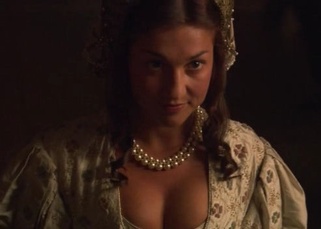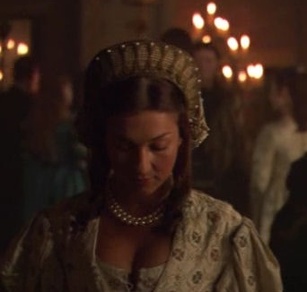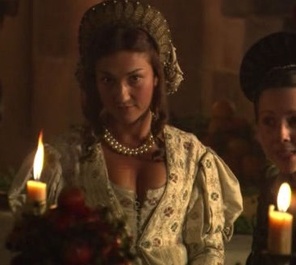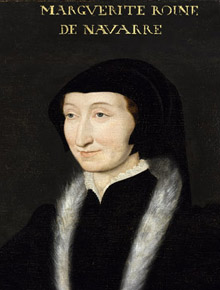Princess Marguerite
Jump to navigation
Jump to search
UNFORGETTABLE CHARACTER QUOTES
DEFINING EPISODES | MEMORABLE SCENES
PHOTOS
Princess Marguerite of Navarre as played by Sara James
Later known as Marguerite of Angoulême, Queen consort of King Henry II of Navarre (French: Marguerite d'Angoulême, Reine de Navarre)
Later known as Marguerite of Angoulême, Queen consort of King Henry II of Navarre (French: Marguerite d'Angoulême, Reine de Navarre)
| Born April 11th, 1492 - died December 21st, 1549 Character's backstory: *This is a fictional character VERY loosely based on an historical one and the series shows Marguerite & Henry VIII having a dalliance which is totally fictitious. Daughter of Louise de Savoy, one of the most learned and politically powerful women of her time, and Charles, count of Angoulême. Her father was a direct descendant of Charles, the 5th, of France. She had many half siblings from her fathers illegitimate relationships. Marguerite's brother became King of France as Francis I in 1515. Marguerite received a fine classical education and grew up to become a true Renaissance woman. When Marguerite was ten, her mother Louise, tried to marry her to the Prince of Wales, who later would become King Henry VIII of England; but this was "declined with thanks". She was forced to marry at age 17, Charles VI of Alencon, considered a "laggard & a dolt" - a marriage of political expediency. He died in 1525 and she then married King Henry II of Navarre. She made his court into a center for the arts and humanities. A writer herself, she was the friend and generous patron of many artists and reformers, whom she protected from persecution. Anne Boleyn had been one of her sister-in-law, Queen Claude's ladies-in-waiting while she was in France & had made her acquaintance. As a patron of humanists and an author in her own right, it was she who encouraged Anne's interest in poetry and literature. She gave her the original manuscript of Miroir de l'âme pécheresse. Later Anne's daughter, Princess Elizabeth Tudor —who would become Queen Elizabeth I —at age twelve, translated this very same poem by Marguerite into English, written in her own hand, to her then-stepmother, the English Queen Catherine Parr. This literary connection among Marguerite, Anne Boleyn, Catherine Parr, and the future Queen Elizabeth I suggests a direct mentoring link between the legacy of reformist religious convictions and Marguerite. [see :<a class="external" href="http://freessays.0catch.com/lizsnyder.html" rel="nofollow" target="_blank" title=" Guilty sisters: Marguerite de Navarre, Elizabeth of England, and the Miroir de l'ame pecheresse. an essay by Susan Snyder">Guilty sisters: Marguerite de Navarre, Elizabeth of England, and the Miroir de l'ame pecheresse. an essay by Susan Snyder </a> Leonardo Da Vinci was her guest after designing a large chateau for her & her brother. She had one daughter who survived infancy & she died aged 57. She passed on the family tradition of strong women to her daughter, Jeanne d'Albert, who became Queen of Navarre in her own right. In 1550 a year after her death, Edward Seymour and Anne Stanhope's 3 young daughters, Jane, Anne and Margaret Seymour would write a tributary poem to her An elegy in 104 distichs on the death of Marguerite of Navarre which their Tutor would publish. England's first female-authored Encomium [a formal expression of praise; eulogy; panegyric]. It was the only work published in any language by English women before the 1560s and the only published poem in Latin of any English women in the 16th century. It caused such a sensation that, a year after its publication, it reappeared in translations into Greek, Italian and French by many famous contemporary poets. "In Marguerite the Renaissance and the Reformation were for a moment one. Her influence radiated throughout France. Every free spirit looked upon her as protectoress and ideal .... Marguerite was the embodiment of charity. She would walk unescorted in the streets of Navarre, allowing any one to approach her and would listen at first hand to the sorrows of the people. She called herself 'The Prime Minister of the Poor'. Henri, her husband, King of Navarre, believed in what she was doing, even to the extent of setting up a public works system that became a model for France. Together he and Marguerite financed the education of needy students." - Historian Will Durant Gentility: French Royalty, Capetian House of Valois by birth. House of Albret by marriage. Position: Princess of France, Queen consort of Navarre, Duchess of Alençon, Countess of Armagnac and Perche Personality type: considered one of the most brilliant female minds in France. Known as the "first modern woman", she was an outstanding figure of the french renaissance. Erasmus wrote to her: "For a long time I have cherished all the many excellent gifts that God bestowed upon you; prudence worthy of a philosopher; chastity; moderation; piety; an invincible strength of soul, and a marvelous contempt for all the vanities of this world. Who could keep from admiring, in a great King's sister, such qualities as these, so rare even among the priests and monks?" Signature look: She was called " the radiant young princess of the violet-blue eyes" also "she was very kind, gentle, gracious, charitable, a great dispenser of alms and friendly to all." Endearing trait(s): Annoying trait(s): |
The First Modern Woman ~ Samuel Whitehall Putnam (1892-1950)
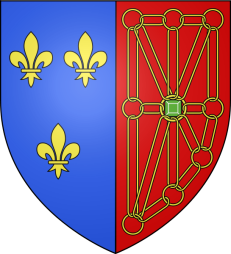 <a class="external" href="http://www.gutenberg.org/files/3841/3841-h/3841-h.htm" rel="nofollow" target="_blank"> 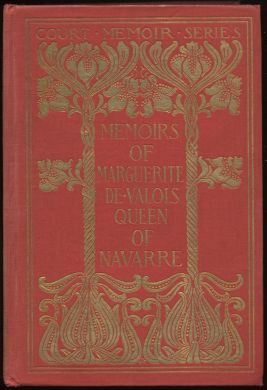 </a> </a>For full documentation online, click the above picture. Click EasyEdit to update this page! (Don't see the EasyEdit button above? <a href="/#signin" target="_self">Sign in</a> or <a href="/accountnew" target="_self">Sign up</a>.) | |||
CHARACTER CONNECTIONSFamily members: Father: Charles, Count of Angouleme (French: Charles d'Orléans, Duc d'Angoulême) Mother: Louise of Savoy, Duchess regnant of Auvergne and Bourbon, Duchess of Nemours (French: Louise di Savoia) Paternal Grandfather: John of Orléans, Count of Angoulême (French: Jean d'Orléans, Comte d'Angoulême) Paternal Grandmother: Marguerite of Rohan (French: Marguerite de Rohan) Maternal Grandfather: Philip II di Bresse, Duke of Savoy (French: Filippo II di Bresse, Duca di Savoia) Maternal Grandmother: Margaret of Bourbon (French: Marguerite de Bourbon)Brother: King Francis I of France (French: François I, Roi de France) Half sisters by father's mistresses: By Antoinette de Polignac, Dame de Combronde: Jeanne of Angoulême Madeleine of Angoulême By Jeanne Le Conte: Souveraine of Angouleme Marriages: 1st Husband: Charles IV, Duke of Alencon (French: Charles IV d'Alençon, Duc d'Alençon), no issue. 2nd Husband: King Henry II of Navarre (Spanish: Enrique II, Rey de Navarre) Daughter: Jeanne d'Albret (Spanish: Reina Jeanne III de Navarre) She was the only surviving child of Marguerite and Henry. Jeanne was mother to King Henry IV of France, founder of the Royal House of Bourbon. Romance: The only person Marguerite was said to be in love with was Gaston de Foix, Duke of Nemours, King Louis XII's nephew, however, he went to Italy in 1511 and was shot and killed at the Battle of Ravenna on 11th April 1512 when the French defeated Spanish and Papal forces. Marguerite was 20 years old at the time. (see pic below) Friends: Francis I of France (her brother) Queen Claude of France Anne Boleyn Enemies: |
UNFORGETTABLE CHARACTER QUOTES
| |
DEFINING EPISODES | MEMORABLE SCENES
|
PHOTOS
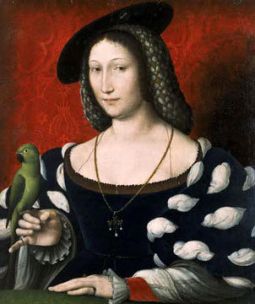 'Princess Marguerite of Angouleme', Jean Clouet, c.1530 This painting is full of symbols which may give clues to the painting's meaning. The sitter wears daisies in her hat. The French word for daisy is Marguerite. The parrot may symbolise eloquence and mean Marguerite was a good speaker. The bird may also symbolise love, its green colour denoting passion. | |
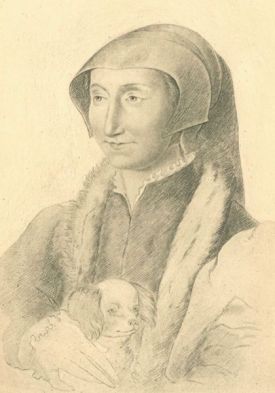 Marguerite de Navarre, from a crayon drawing by François Clouet, preserved at the Bibliothèque nationale de France, Paris. | 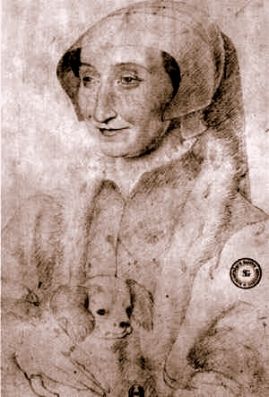 Original drawing of Marguerite de Navarre, from a crayon drawing by François Clouet |
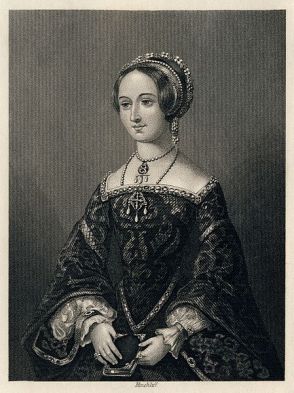 Hinchliff's engraving of Marguerite of Navarre, from an 1864 English edition of the Heptaméron. | 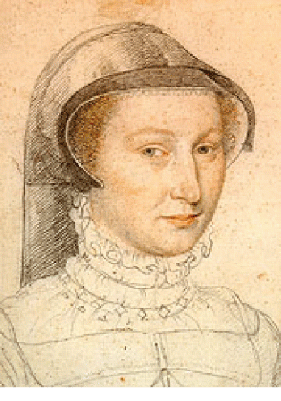 Marguerite, Queen consort of Navarre |
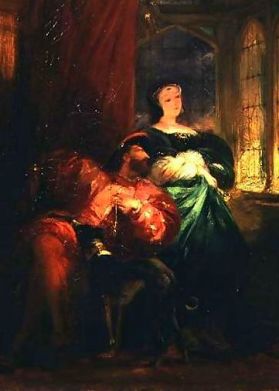 "Francis I and Marguerite de Navarre" by Richard Parkes Bonington | 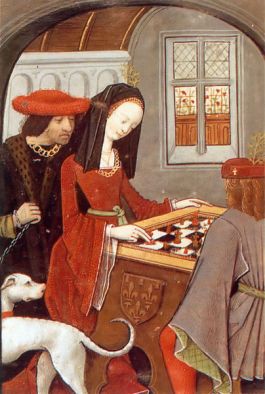 Marguerite and her brother, Francis I playing chess. |
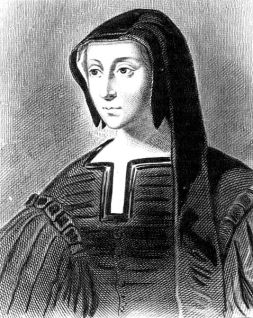 Louise of Savoy, Duchess regnant of Auvergne and Bourbon Marguerite & Francis I's mother. She was a major influence in both their lives. Louise of Savoy remained politically active on behalf of her son in the early years of his reign especially. During his absences, she acted as regent on his behalf. Louise served as the Regent of France in 1515, during the king's war in Italy, and again from 1525 to 1526, when the king was at war and during his time as prisoner in Spain and in 1529. | 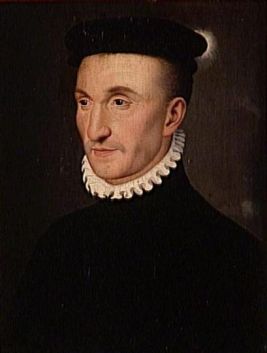 Henri d'Albret by an unknown French painter Henry II, King of Navarre (18 April 1503 – 25 May 1555) Second husband to Princess Marguerite. Eldest son of John III of Navarre (died 1516) and Catherine I of Navarre, sister and heiress of Francis Phoebus, King of Navarre. |
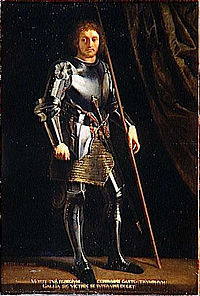 Gaston de Foix, Duke of Nemours (1489 - 1512) Was said to be the love of Marguerite's life. Gaston was the nephew of Louis XII of France. He was a son of John of Foix, Viscount of Narbonne and Marie d'Orléans. His paternal grandparents were Gaston IV of Foix-Grailly and Queen regnant Eleanor of Navarre. His maternal grandparents were Charles, Duke of Orléans and Marie of Cleves, great-great-aunt of Queen Anne of Cleves. His only maternal uncle was Louis XII of France. | 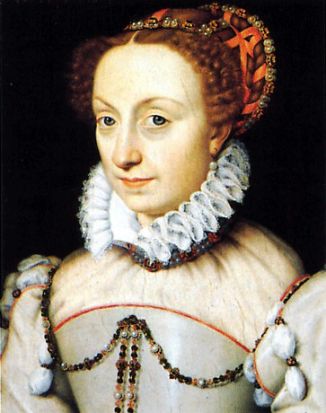 Marguerite's only surviving daughter and child, Jeanne d'Albert, who became Queen regent Jeanne III of Navarre |
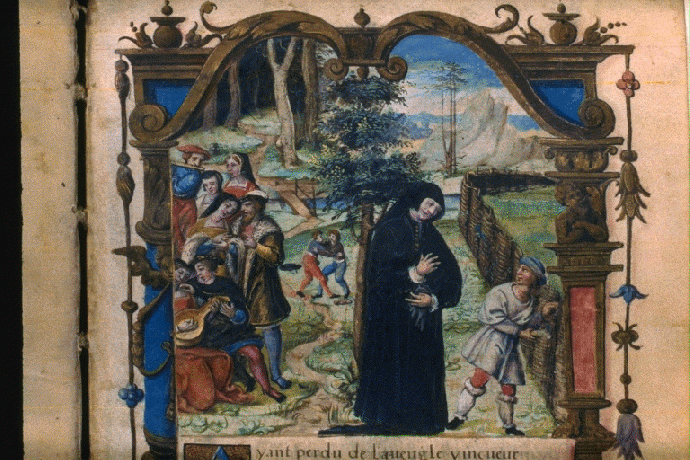 from the beginning of Marguerite's 'La Coche ou le Debat de l'Amour': France, c.1540 |
| Quote from <a class="external" href="http://faculty.mccfl.edu/jonesj/JanesPPT/Courtly/..%5C..%5Cenl2010%5CNovelle.htm" rel="nofollow" target="_blank" title="Romance Form in the Late Middle Ages.">Romance Form in the Late Middle Ages.</a> : "The most important and influential sixteenth-century French collection of nouvelles is L'Heptaméron (1558, 1559) by Marguerite of Navarre. Marguerite de Valois (1492-1549), sister to King François I of France, duchess of Alençon (married 1509 to Charles, Duc d' Alençon) and queen of Navarre (married 1526 to King Henri II of Navarre) was at the center of the brilliant French court, introducing refinements which would lead to the literary salon society of the Seventeenth Century. As patron of such literati as Rabelais and Des Périers and protector of religious reformers, she participated in the major intellectual movements of her time. Marguerite commissioned the first French translation of the Decameron by Le Maçon in 1545. The French court and Marguerite herself had long considered a French version of Boccaccio's masterpiece. After her brother died, Marguerite spent more time at her husband's estates and began to put together the work that would become L'Heptaméron, a collection of seventy-two stories told by ten aristocratic devisants or storytellers. Like Boccaccio's collection, Marguerite's is occasioned by a natural disaster, in this case a flood. While they await the building of a bridge replacement, her travelers decide to tell stories to pass the time -- but restrictions are put on the tales: each must be a tale of something the narrator either witnessed or heard from a reliable source and the stories must be told without literary rhetorical devices. Marguerite's storytellers are all based on members of her circle, including herself and her husband, and the discussions that ensue reflect a variety of philosophical and moral positions. Unlike most of her contemporaries, Marguerite took the institution of marriage seriously and she understood the complexity of the human condition. The theme of love is intertwined with social and religious concerns, not simply an occasion for bawdy laughter. Indeed, love, marriage and the relationship between the sexes are more often problematic than pleasurable in L'Heptameron. Marguerite's influence was central in fostering French humanism, and L'Heptameron served as a stylistic, if not thematic, model for such seventeenth-century collectors of tales as Perrault and LaFontaine." |
